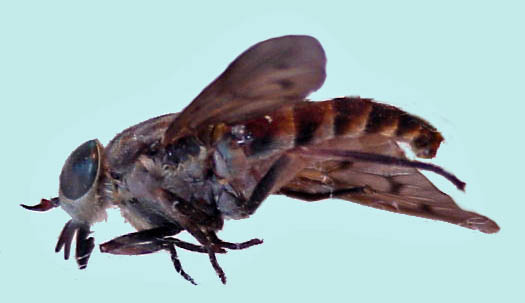So, You Think You Love Horses?
Some Reflections on the Nature of Horses and Man
More Discussions by “The Accidental Horseman”
Horse Flies
Side View of a Horse Fly
Quelle mouche t'a piqué ?

|
Top View of a Horse Fly
It is over 30mm long and its bite hurts.

| |
There are a number of insects that torment horses but none torment them more effectively than the horse fly. They are noisy, fast moving and persistent. One fly can drive a herd of horses bucking and running into a barn on a summer’s day before they can eat a single bite of grass. It seems that the fly backs off as soon as the horses cross the threshold between bright daylight and a darkened barn. I suppose this is a programmed reflex of the fly that equals a shadow of something coming down on it and causes it to break off its attack. However, even worse is when you are on a horse’s back and one gets after your horse. Hopefully a fast swat or a fly whisk will remove it before the horse starts bucking. These flies are smart and often pick an area on the horse’s back where the tail meets the body and the poor horse can do little to get it off. You wonder just how the flies know where to go, but they do. Also they always seem to land on the opposite side from where you are standing when you are dismounted and leading a horse.
Justin Macquart

|
|
The scientific name of the horse fly that we have here in the eastern United States is Tabanus sulcifrons. The species was first named and described in an 1855 publication by the famous French entomologist and fly scholar, Justin Pierre Marie Macquart (1776–1855). I have no doubt that M. Macquart’s passion for flies caused him to be in great demand at the famous literary salons of 19th Century Paris. Interestingly enough, the specimens that Macquart studied were collected for him in nearby Baltimore, Maryland and thus were cousins to the ones tormenting my own horses at this very minute! I wonder why no one prior to Macquart ever noticed a horse fly? They do announce their presence loudly and they are generally acknowledged to be one of the largest species of fly and yet the species did not enter the taxonomic lexicon until 1855. I can only assume that most early entomologists were not particularly good horsemen and ended up on the ground with the air knocked out of them in a vain attempt to recover a specimen. [For those of a more serious frame of mind I really do know the answer to my own question but I am having a little fun here and will not tell the only too boring rest of the story. You really do not need to know, trust me, but here’s a hint, think Bullock's oriole. My Baltimore friends will figure that one out instantly.]
Photomicrograph of the Tarsal Claw of a Horse Fly
Credit: Duke University Images
|
| 
|
T. sulcifrons is well adapted to its mission. Only the female of the species bites. They must have a blood meal to reproduce. Their mouth parts are relatively short compared to other biting insects and they tear the flesh open rather than just poke in a thin proboscis the way female mosquitoes do. This is one of the reasons that the flies drive horses to distraction. They are known also to bite humans and their bite really hurts. If undisturbed they can remain on their victim for several minutes. For whatever reason, it is unusual for them to be in swarms and usually you will contend with one fly at a time. Experts say that, similar to sharks, they will initially circle their intended victim, but any horse person knows that already. They hunt by sight and are attracted to large moving objects that contrast with their surroundings. They will not only go after horses but also cattle, deer and other larger animals. It seems that if you cover your horse in a cammo outfit you should be able to fool the flies. I need to try that. It may help out in hunting season as well. If it does not fool the hunters at least it may cause them to feel a certain comradery with the herd. Fly repellants are generally acknowledged to be worthless, but there are stationary traps that are said to be effective. The fly larvae you notice in manure are not those of the horse fly. Horse flies lay their eggs in vegetation in moist areas and go through a larvae stage prior to becoming adults. There is only one generation a year. Their legs are adapted to hang on their victim and end in miniature grappling hooks. This winter when you traipse down to the barn to feed your horses and your fingers are numb and your nose cold consider that at least you have the consolation that there is not a fly in sight.
The Accidental Horseman.
Back to Additional Discussions
Links to Other Sites regarding Horses
Back to Index Page

